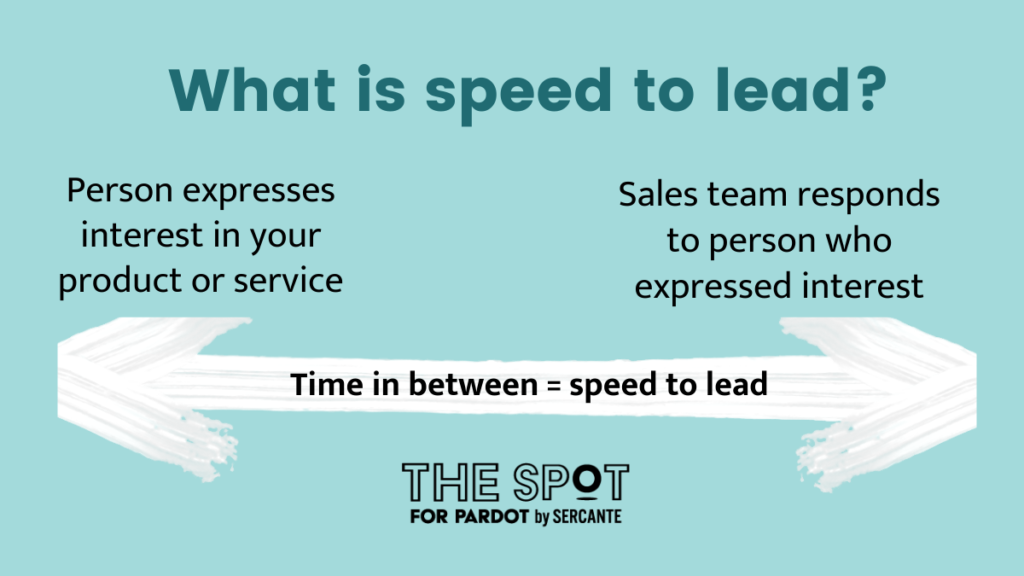When speed to lead is important, clean Pardot data is key.
In sales, a lot can be said about timing. Catching a prospect on a good day, at the right time and with the right question or topic can fast-track a deal you’ve been chasing for months. And as marketers, we are in the unique position to ensure that we start the lead process off with the best timing by focusing on ways to increase, what sales calls, our ‘speed to lead’.
What does ‘speed to lead’ mean in sales & marketing?

Speed to lead is defined as the amount of time between someone expressing interest in your company and your sales team’s first response. You’ve probably seen it happen (the Salesforce sales team does too good of a job at this): you fill out a form on a website. As soon as the confirmation hits your inbox, your phone rings with a salesperson asking if you have any questions.
This behavior is known to produce good sales outcomes if it’s done sincerely and with tact (so you don’t become annoying and badger potential clients). A lot of ‘speed to lead’ discussion is had with companies that measure first responses in single-digit minutes. But every organization benefits from decreasing the time it takes for a hand-raiser to get to the sales team.
Get clean data and improve speed to lead time
Now, let’s put our marketing operations hats back on. What happens if the data you’re receiving about Pardot Prospects is incomplete or incorrectly formatted? You might get “U.S.A.” and then have a sync error because Salesforce has “State and Country Picklists” enabled. On the other hand, you might be fighting the battle between needing more complete data for routing versus not deterring prospects from completing a form.
You can take action from the Pardot side before the data gets into Salesforce. Utilize completion actions, automation rules, and engagement studio programs to clean up known and recurring issues with data. Depending on the tool you use, there will be some delay in processing the data. But if sales isn’t clamoring to measure speed to lead in minutes, then you should be okay. Those automations all have their pros and cons. However, you should be able to use them to clean up a certain amount of data automatically. One of the biggest hurdles you’ll have to address the growing complexity of trying to add a new automation for each field (and cleaned field value) you want to fix.
One note when making these data cleaning rules: make sure you think through how you’re using the “Contains” filter because “Country CONTAINS ‘DE’ will match “DE” (Germany) AND “Denmark.”
Send incomplete lead records to Salesforce first
If your data rules are less stringent, then you might be able to get the data into Salesforce before cleaning. We like to assign the not-yet-clean leads to a marketing queue. But you have a lot more options for cleaning data than we do in Pardot if you can sync incomplete or incorrect data to Salesforce and hold off on assigning leads to a queue. AppExchange products, Flow, and custom Apex classes can all work to help you normalize, standardize and enrich the data. Once you have clean data, then you can use a Flow/Apex/AppExchange product to re-route the lead to the right spot.
Clean Pardot data at the source
Another place to look for cleaner data is at the source. Optimize your conversion points to ensure data fits your needs as it enters your org. For example, make sure your web form state and country fields are picklist/dropdown fields. Then verify that the values match what is in your Salesforce org’s state and country picklists. Bonus points if you can restrict the state to the selected country. Also, we’ve found that some lead generation vendors have ‘standardized’ their data to meet their own set of standards. For instance, they may be using employee count ranges instead of the exact value. Since you’re essentially paying them for data, then you should be able to convince them to format their data to YOUR standards.
It’s also worth a note here on where to look for data problems to begin with. The first place to check (regularly) is your Sync Errors list in Pardot Settings. This will give you a list of every Prospect who was unable to sync to Salesforce and the reason why. Occasionally these reasons can be cryptic, so get your Google-fu ready and go find your Salesforce Admin (if that’s not also you). Bucket the list of errors together, and look for commonality and patterns. See if you can then determine the root cause of the errors and if they are one-offs or repeatable issues you need to resolve.
Find data issues in Salesforce Reports
Another place to look for issues is in Salesforce Reports. I love seeing a freshly created dashboard because of the data story it tells. It’s usually an eye-opening story about bad or incomplete data.
Here’s an example of something to look for in these types of reports:
- Open a lead report.
- Look for leads that have met your stated ‘assign to sales’ threshold.
- Identify the ones that have met the threshold but are still assigned to the Pardot connector/integration user, or they are still in your marketing queue.
Why aren’t those leads assigned to sales? They’re growing mold and you’re losing money. If it’s one or two, it might be a fluke. It’s still worth it to take a look. If it’s a lot of leads, then it’s time to roll up your sleeves and figure out what’s going wrong — quickly.
Improve speed to lead times with Pardot tools
Clearly we’ve seen these situations happen in many Pardot orgs and have felt this pain (and continue to feel this pain). So, you’re not alone. Over the years, our Sercante Labs team has found ways to automate this pain away for ourselves and our customers. It’s turned into a tool that we simply call Prospect Updater for Pardot.
Prospect Updater helps us do advanced data cleanup and enrichment inside Pardot. That means data is cleaned BEFORE prospects are assigned and in Pardot. The tool works wonders with clamping down on spam-bot submissions on your forms.
Where have you seen the biggest data issues arise and how have you dealt with them? Ping us on Twitter or add a comment below. And reach out to us to learn more about using Prospect Updater for Pardot in your org. Here’s to good leads and clean data!








